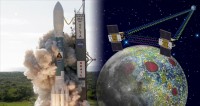The spacecraft will move in the structure, one after the other in the same orbit, and will transmit a signal to each other to measure the distance between them. The distance between them should be known in advance, but differences between the average gravitational force of the moon and the force that will be exerted on the spacecraft as a result of the area they pass over will cause their speed to change

The pair of Grail spacecraft reach the moon after a long journey of almost four months in space. On Saturday, the Grail A spacecraft entered an elliptical orbit around the moon exactly according to the plan. Today the second spacecraft enters orbit around the moon, and after three months of organization, experiments and calibrations will begin their mission - mapping the moon's gravity field. The information that will be produced will make it possible to draw conclusions about the internal structure of the moon and thus about the processes of its formation.
One of the mysteries related to the structure of the moon is the difference between the side close to the earth and the far side. If we look at the following topographic map, which shows in color the height differences of the surface relative to the average height (red/white=high, blue/purple=low), we can easily see that all the high sites are on the far side, and the reason for this is unknown to us.
The spacecraft will move in the structure, one after the other in the same orbit, and will transmit a signal to each other to measure the distance between them. The measurement resolution is one tenth of a micron, that is one ten-millionth of a meter! When they are in the same orbit, the distance between them should be known in advance, but differences between the average gravitational force of the moon and the force that will be exerted on the spaceships as a result of the area they pass over will cause their speed to change, and consequently the distance, and that will be measured.
This way we can learn about the gravitational field around the moon and especially on its far side, where measurements of this type have never been conducted.
The flight of the two spacecraft will be at an altitude of only 25 to 50 kilometers above the ground, a distance that will result in very detailed mapping, and in a polar orbit (above the poles) so that the entire surface of the moon will be mapped by the beginning of June. During this period, the flight path will pass within the shadow of the moon for extended hours where the two depend on the energy of their batteries [the last sentence is incorrect, see correction below]. Therefore, the spacecraft engines will be activated to raise the orbit to an altitude of over 300 kilometers, where the duration of the stay in the shadow will be shorter.
If the mapping is successfully completed by the beginning of June, and the batteries last, the mission may be extended for another mapping that will last until the end of December. In June, a lunar eclipse will occur - the entire moon and its surroundings will enter the earth's shadow. The batteries of these spacecraft were not designed to withstand the cold and the inability to produce electricity from sunlight for a long time, so the mission was planned to end before then. Today, after the spacecraft systems have been tested in space, it seems that they will be able to withstand this situation. In any case, the extension of the mission depends on the budget, so we'll wait and see.
In any case, after the mission is over, the two are expected to deliberately crash on the lunar soil. Simply to not leave bodies without control on the track.
The entry of Grail-A into orbit around the moon will be on the night of Saturday 31/12 at 23:21 (Israel time, UTC+2), and that of Grail-B on the night between Sunday and Monday at 00:05 (Israel time). Each of the spacecraft will run its main engine for 40 minutes for the maneuver. If due to some malfunction one of them fails to perform the maneuver, she will have to wait until April for the next opportunity. After both are in orbit around the moon, their new names will be announced, which we hope will be more original than A and B.
I will try to update in real time on Twitter and on the Facebook page, and I would be very happy if you would join me.
The news was first published on Yoav Landsman's blog "Critical Essay"

3 תגובות
To Mickey, a mistake! The moon does rotate around its axis, but there is a synchronization between the speed of its rotation around the axis and the speed of its rotation around the Earth.
By the way, in another article I read, there is an explanation as to why the mountainous part of the moon is facing the unseen side.
It actually makes sense that there is more material on the side of the moon that does not face the earth, because statistically there is a greater chance of a meteor impact on the side that was not protected by the earth for several billion years, since as we know the moon does not rotate on its axis. If it were the other way around then it would really be a mystery. This claim can be proven by layering the different types of material on each side.
The far side of the moon is also characterized by topography. On average, it is higher than the side facing the earth, which suggests the possibility that the specific gravity is lower.